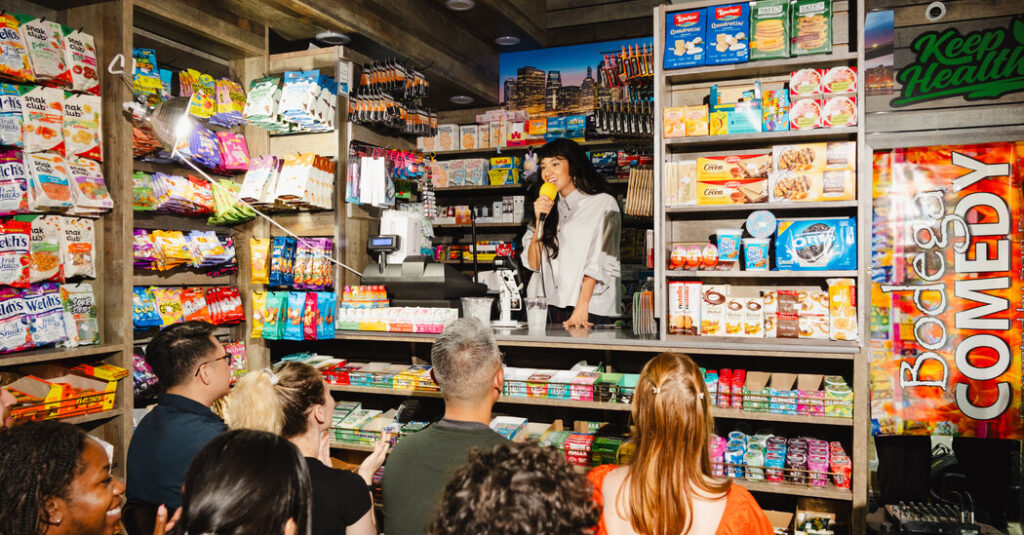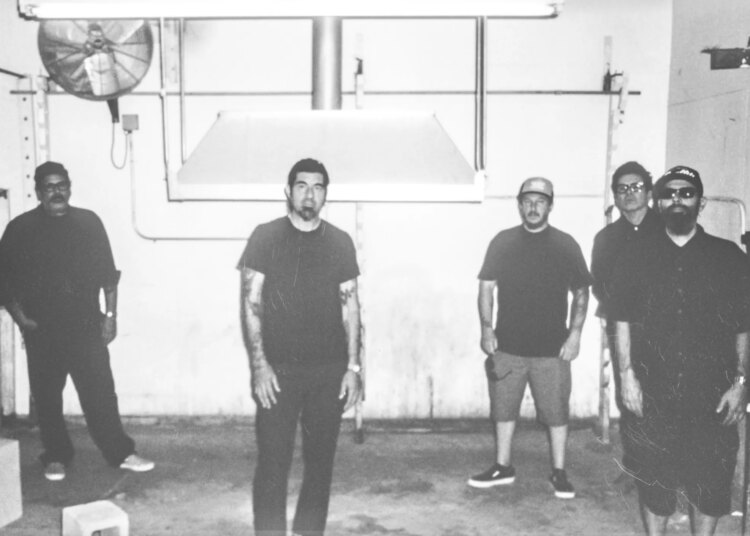It’s 2 a.m. in New York City. The streets are mostly empty, and the shops are mostly closed. But you’re awake, outside and desperately hungry. There’s only one place you want to go.
The familiar yellow awning of your favorite bodega beckons. You step under it, then into the glare of fluorescent lights. All you have to do is nod at the man behind the counter: He knows you want to order a chopped cheese. As you grab a lottery ticket and a pack of gum while you wait, an orange cat peeks out from between boxes of Froot Loops. She’s awake, too.
Bodegas, those small corner stores dotting blocks throughout the five boroughs, have been an essential part of city life for decades. The term, popularized by Puerto Ricans, loosely translates from Spanish to “warehouse.” They’re perhaps the ultimate symbol of a city constantly evolving and on the move.
“We’re a traveling city — people need things on the go and quick,” said Kel Murphy, 41, who grew up working in his father’s bodega in St. Albans, Queens. “Run in, run out. You don’t have to walk through a maze of aisles.”
Bodegas are beloved characters of the city, inextricable parts of the cultural zeitgeist. This year, the rapper Cardi B, who is from the Bronx, released a song called “Bodega Baddie.” New Yorkers have hosted raves, comedy shows and political events in the stores. And they’ve served as spaces for generations of immigrants to find community, work and a taste of home.
Over the years, bodegas have been at risk. Hundreds closed during the coronavirus pandemic. They’ve contended with shoplifting, A.T.M. thefts and police crackdowns. In an age of increasingly high rents, growing chain stores, endless food delivery apps and a health-obsessed population, it’s somewhat of an urban miracle that bodegas are still around.
Still, you’re usually never more than a few blocks away from one. In 2022, there were around 7,300 bodegas in the city, according to the Health Department. How did theses humble but crucial parts of New York’s infrastructure come to be, and how will they evolve to continue enduring?
Born of immigrant culture
Jewish and Italian immigrants established delis in New York in the late 1800s and early 1900s. Some later sold their shops to a growing community of Spanish-speakers migrating from Cuba, Puerto Rico and Spain. Bodegas, as we know them, then began to take off around the 1920s.
They became “neighborhood anchors,” said Pedro A. Regalado, an assistant professor of American history at Stanford University and the author of the forthcoming book, “Nueva York: Making the Modern City.”
They sold nostalgia: rice, beans, plantains, chorizo and other foods that were reminders of home. This commercial pursuit helped create a “pan-Spanish speaking community,” said Mr. Regalado, adding that an ethnic identity began to form as bodega owners, called bodegueros, referred to their stores as being Latino or Hispano.
By the 1980s, many Puerto Ricans had sold their bodegas to Dominicans; by the 2000s and 2010s, many Yemeni immigrants owned them. The entire time, though, “the identity of the bodega doesn’t change that much,” said Mr. Regalado.
Now, the cultural diversity and fusion that defines New York is embodied in these spaces. On the Lower East Side, there is the Chinese Hispanic Grocery, where you can buy chicharrones and lychee juice. Near the border of East Williamsburg, Brooklyn, Edimar Piña and José Herrera, who are from Venezuela, began serving arepas and tequeños after taking over a Mexican bodega to start Codigo 58. “We still have tacos, quesadillas, burritos because we wanted to keep the old customers,” said Mr. Herrera.
“We’ve never closed, ever”
When you need it most, the bodega is always there for you. The stores never have more than a few aisles, but like a Mary Poppins bag, they somehow almost always have what you’re in search of. They’re also some of the most adaptable businesses.
During the pandemic, bodegas were the only place where some New Yorkers could find hand sanitizer and paper towels. When the spread of bird flu led to a spike in egg prices, they sold loosie eggs.
“All you got to do is come in here and tell me what you want,” said Francisco Suriel, the owner of Hollis Ave Mini Market in Queens. “Believe me, tomorrow you will have it.”
A key part of their appeal is how easy it is to find one. “When you walk right by a bodega on your daily route, the convenience rivals a delivery service,” said Nate Storring, the co-executive director of the nonprofit Project for Public Spaces. He added, “Whether you forget your umbrella on a rainy day or you’re parched on a hot one, you’re rarely far from a place that can help you out.”
Jullya Kim, whose family has owned Sunny & Annie’s Deli in the East Village since 1997, said they kept the store running with candles and battery-operated lamps during the blackout of 2003. “We’re open 24 hours, 365 days a year, seven days a week — and we’ve never closed, ever,” Ms. Kim said. “Not even during hurricanes.”
In our current age of no-contact grocery delivery and sterile self-checkouts, moments for human interaction are fading from everyday life. Bodegas are “a quiet part of New York’s social infrastructure that stops us from feeling lonely in a big city,” said Mr. Storring.
Because many of them are literal mom-and-pop stores, the employees are often friends or relatives who are invested in the vibe of the space. “Anyone who walks in the doors, we always say ‘Hi!’ with a loud-tone voice,” said Ms. Kim.
Sam Boston, who manages a bodega in Hudson Yards, said, “When I see a customer is having a bad day — I can see it in their face — I try to crack a joke or make them smile.”
Celebrity status
Bodegas have become a defining aspect of the city’s mythology, earning a cultural cachet that resonates beyond New Yorkers. Rihanna once appeared on the cover of Paper Magazine posing in front of a bodega fridge. And on TikTok, a few years back, a BIA song with the lyric, “I put on my jewelry just to go to the bodega,” went viral.
The corner stores have a coolness about them, and an avid fan base in a way that, say, Kroger does not. This was spurred, at least in part, by hip-hop artists in the 1980s and ’90s who emerged from lower-income neighborhoods where bodegas were popular. Nas stood on top of an awning that reads, “Fruits — Vegetables,” in his “Hate Me Now” music video. Biggie Smalls, as a teenager, famously freestyled in front of a bodega in Bedford-Stuyvesant, Brooklyn, in 1989. And more recently, A$AP Rocky and Ice Spice have also used bodegas as visual backdrops.
Mr. Murphy, who is creating a documentary about the stores, said that for the hip-hop artists, the bodega was “their oasis in a food desert.”
“When they blow up, they don’t forget about their bodega,” he said. “This is something that sustained them.”
Supermarkets and chain grocers have often avoided neighborhoods with higher concentrations of people of color and low-income residents. For some New Yorkers, bodegas were, and in some cases still are, the only option for food and other basics.
The cultural significance has also made New Yorkers protective. In 2017, when former Google employees created a convenience shopping app — and called it Bodega — public outrage followed, and the business eventually shuttered.
What’s next?
A few years ago, Mr. Boston was working at a bodega in Boerum Hill, Brooklyn. He became friends with one repeat customer, Christopher Isaacson, a comedian who lived in the neighborhood and was looking for spaces to host D.I.Y. comedy shows. They had the idea of hosting one in the bodega.
The store was transformed into a stage. “Everybody at a comedy show is always afraid to sit in the front because you feel like you’re going to get called on, but in a bodega, everyone is in the front row,” Mr. Isaacson said. Under the name Bodega Comedy, they now host shows in bodegas all around the city. Some tickets have come with a chopped cheese or a Lafufu.
“There’s a sense of freedom” in the bodega that can be hard to find at traditional venues, Mr. Isaacson said.
From the start, bodegas have been flexible spaces, allowing for a natural evolution that keeps them from becoming outdated. And for better or for worse, they’ll continue to change in other ways, too.
“My dad still wants to keep it 24 hours, but it’s just costing a lot more than what it used to,” said Ms. Kim of Sunny & Annie’s.
Labor has become more expensive, and they also want to cut down on groceries and instead lean into prepared meals, especially Korean foods like kimbap. “We can’t compete with all these supermarkets, but what we can do is offer things that they’re not,” Ms. Kim said. She added that she’s also thinking about introducing a juice bar or salad bar, for the increasingly health conscious.
At Codigo 58, customers frequently come in “asking for natural juice,” said Mr. Herrera, adding that he plans on buying a juicer to make fresh strawberry, cantaloupe and papaya juices.
Back in 2023, the business almost closed, Ms. Piña said. “We didn’t have enough money,” she said. That’s when she decided to start an Instagram, with posts showing off the shop’s empanadas and yuca fries. “It worked,” she said. “People see our videos and they want to try our food.”
In recent years, several bodegas have blown up on social media, with viral videos of making sandwich orders and rewarding children with free treats when they answer math questions correctly.
Even if their hours and the items they stock on their shelves change, there is one thing that will perhaps never disappear from the bodega — the human touch.
“It’s the warmth that we give to our customers,” said Ms. Kim. “It’s very, very important that customers know that we see them and know that we’re there.”
Even in the middle of the night, at least for now.
Anna Kodé writes about design and culture for the Real Estate section of The Times.
The post Why the New York Bodega Is Here to Stay appeared first on New York Times.




